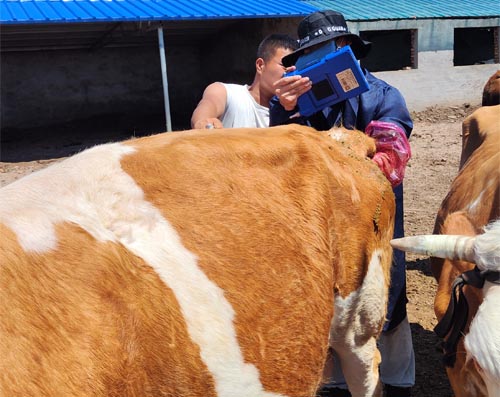Bovine Ultrasound for Early Detection of Reproductive Disorders
Reproductive health is a cornerstone of successful cattle farming. Fertility problems can quietly reduce herd productivity, delay calving, and increase costs. Traditionally, farmers relied on visual observation or manual palpation to detect reproductive issues, but these methods often miss early signs. Bovine ultrasound changes that by offering a clear, non-invasive view inside the cow’s reproductive system, enabling farmers and veterinarians to detect disorders before they escalate.

Common Reproductive Disorders in Cattle
Cattle can develop several reproductive disorders that affect fertility, including ovarian cysts, uterine infections, and follicular abnormalities. Left untreated, these conditions can delay conception or lead to repeated breeding failures. Early detection is key because timely treatment often restores fertility and prevents long-term herd losses.
For instance, ovarian cysts may cause irregular estrous cycles, making it hard to predict ovulation. Uterine infections reduce conception rates and may increase calving complications. By using ultrasound, farmers can spot these conditions early, decide on treatment plans, and minimize the economic impact on the herd.
How Ultrasound Detects Disorders Early
Ultrasound provides a real-time image of the ovaries, uterus, and follicles. This allows veterinarians to identify abnormalities that are invisible through palpation or observation alone. For example, cystic structures on the ovary or fluid accumulation in the uterus are easily seen on the screen, enabling precise diagnosis.
Early detection helps farmers intervene before problems worsen. A cow diagnosed with a uterine infection can receive antibiotics promptly, while an ovarian cyst can be treated or monitored to restore regular cycles. This proactive approach ensures cows return to normal fertility faster, reducing open days and increasing overall herd efficiency.

Improving Breeding Programs with Ultrasound Data
By detecting reproductive disorders early, ultrasound also improves the success of breeding programs. Farmers can avoid inseminating cows that are not ready, preventing wasted semen and failed breedings. In addition, cows treated early for reproductive issues are more likely to conceive on the first attempt.
This data-driven approach allows farmers to plan breedings with confidence. It ensures higher conception rates, fewer repeat cycles, and more predictable calving intervals. Ultimately, integrating ultrasound into reproductive management creates a more reliable and efficient herd.
Protecting Cow Health and Reducing Stress
Reproductive disorders are not just about fertility—they also affect cow welfare. Conditions like uterine infections or ovarian cysts can cause discomfort or pain if left untreated. By using ultrasound to detect these problems early, farmers can provide timely care, improving both health and welfare.
Cows that are diagnosed and treated promptly experience less stress during breeding and pregnancy. This contributes to smoother calving and reduces the risk of complications, which benefits both the cow and the newborn calf. Healthy cows are also more productive, producing better-quality milk or beef.

Reducing Economic Losses Through Early Detection
Undiagnosed reproductive disorders can be costly. Repeated failed breedings, longer calving intervals, and veterinary emergencies all drain resources. Ultrasound allows farmers to reduce these losses by identifying problems early and addressing them before they affect herd productivity.
Here’s an example of the economic impact:
| Factor | No Ultrasound Monitoring | With Ultrasound Monitoring |
|---|---|---|
| Conception success | Lower, multiple inseminations needed | Higher, first-attempt success more likely |
| Open days | Longer, lost milk production | Shorter, more predictable calving |
| Treatment costs | Higher, delayed intervention | Lower, early detection and treatment |
| Herd productivity | Reduced, fewer calves born | Improved, more calves and better milk yield |
Early detection not only saves money but also strengthens the herd by keeping cows healthy and fertile.
Integrating Ultrasound Into Routine Herd Management
To maximize the benefits, ultrasound should be part of routine herd management rather than used only when problems arise. Periodic checks of all breeding cows can help detect reproductive disorders before they affect fertility.
Farmers can schedule regular scans during estrous cycles or early pregnancy. These proactive checks provide a comprehensive view of herd reproductive health, helping farmers make informed decisions about breeding, treatment, and nutrition. Over time, this approach reduces unexpected issues and keeps the herd operating efficiently.
Conclusion: A Vital Tool for Fertility and Herd Efficiency
Bovine ultrasound is more than a diagnostic tool—it’s a strategy for maintaining reproductive health and optimizing herd productivity. By detecting ovarian, uterine, and follicular disorders early, farmers can intervene promptly, protect cow welfare, improve breeding success, and reduce economic losses.
For modern cattle operations, incorporating ultrasound into reproductive management is no longer optional. It is a critical investment in the long-term health, efficiency, and profitability of the herd.





